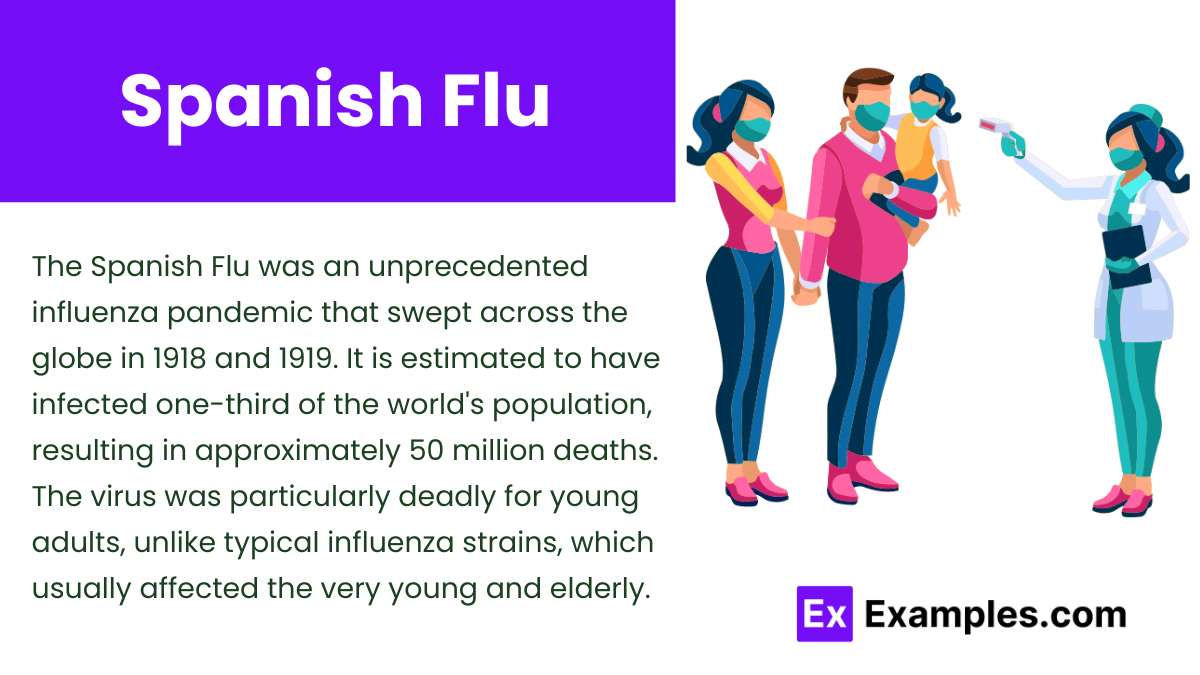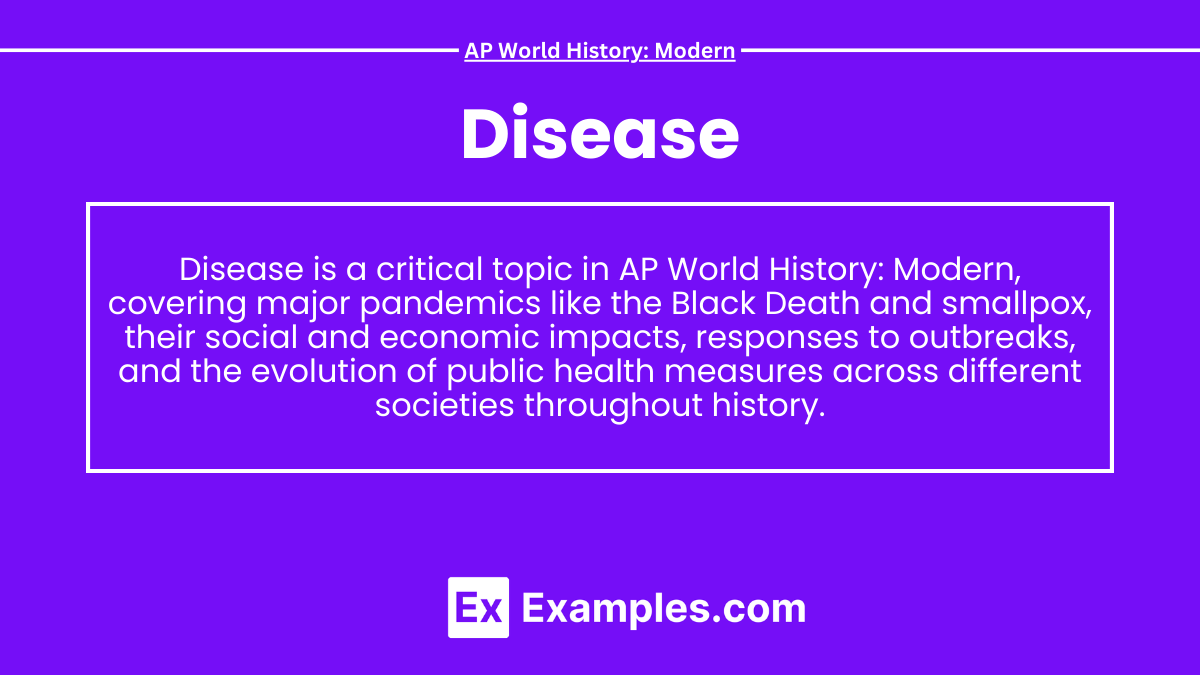Disease significantly impacted societies throughout history, shaping economies, cultures, and politics. Major outbreaks, such as the Black Death and the Spanish flu, disrupted populations and economies, leading to social change and new medical practices. Understanding the role of disease is crucial for AP World History: Modern, as it reveals the interconnectedness of societies and the evolution of public health responses.
Learning Objectives
In studying “Disease” for AP World History: Modern, you should learn to identify major diseases that impacted societies, analyze their effects on populations and economies, and evaluate how disease outbreaks influenced historical events. It’s also crucial to explore the role of disease in shaping cultural exchanges and public health responses, providing a comprehensive understanding of its global significance throughout history.
1. The Black Death (1347-1351)

The Black Death, a devastating pandemic in the 14th century, killed millions in Europe. It transformed society, weakened feudalism, and led to significant economic and cultural changes across the continent.
- Overview: Originating in Central Asia, the Black Death spread through trade routes, particularly the Silk Road, reaching Europe and decimating populations.
- Impact:
- Demographic Changes: It is estimated that 25-30 million people in Europe died, reducing the population by one-third.
- Social Upheaval: Labor shortages led to increased wages for workers, weakening the feudal system and contributing to the rise of a middle class.
- Cultural Responses: Art and literature reflected the trauma of the period, with themes of death and mortality becoming prevalent.
2. Smallpox (16th-19th centuries)

- Overview: Smallpox, caused by the variola virus, was a highly contagious and deadly disease that primarily affected humans. It is characterized by fever and a distinctive skin rash that leads to scarring. The disease was responsible for countless deaths throughout history, particularly after European colonization of the Americas.
- Impact:
- Demographic Collapse: Many indigenous communities experienced mortality rates exceeding 90%, facilitating European conquest and colonization.
- Medical Advances: The development of the smallpox vaccine by Edward Jenner in the late 18th century marked a milestone in medical science, eventually leading to the disease’s eradication.
3. Spanish Flu

- Overview: The Spanish Flu was an unprecedented influenza pandemic that swept across the globe in 1918 and 1919. It is estimated to have infected one-third of the world’s population, resulting in approximately 50 million deaths. The virus was particularly deadly for young adults, unlike typical influenza strains, which usually affected the very young and elderly.
- Impact:
- Post-War Challenges: The flu compounded the difficulties faced by societies recovering from World War I, leading to widespread social unrest and changes in public health policies.
- Public Health Developments: It underscored the need for coordinated public health responses and better healthcare systems.
4. HIV/AIDS (1980s-present)

- Overview: HIV (Human Immunodeficiency Virus) is a virus that attacks the immune system, leading to AIDS (Acquired Immunodeficiency Syndrome), a condition characterized by severe immune system deterioration. The epidemic emerged in the early 1980s, primarily affecting marginalized communities, including gay men and intravenous drug users.
- Impact:
- Social and Cultural Shifts: The crisis led to changes in attitudes towards sexuality and significant activism for LGBTQ+ rights and public health awareness.
- Medical Innovations: Advances in treatment, such as antiretroviral therapy, transformed HIV/AIDS from a fatal diagnosis to a manageable chronic condition.
The Broader Impact of Disease on Society

Social Change
- Disease outbreaks often disrupt established social orders. For instance, the labor shortages caused by the Black Death led to greater social mobility and a reevaluation of class structures.
- Public health crises can catalyze social movements, as seen with HIV/AIDS activism, which brought attention to issues of equity and access to healthcare.
Economic Consequences
- Epidemics can severely disrupt trade, agriculture, and economies. For example, the Black Death led to a decline in agricultural production due to decreased labor availability.
- The need for improved healthcare systems and responses to disease often drives economic investment and innovation in medical technologies.
Political Responses
- Governments historically have had to adapt to the challenges posed by disease outbreaks. Measures such as quarantines, travel restrictions, and vaccination campaigns are responses that emerged during significant health crises.
- The establishment of public health institutions and protocols reflects the recognition of disease as a critical factor in national stability and security.
Examples
Example 1: Typhus
Often spread by lice in overcrowded conditions, typhus outbreaks have historically affected soldiers and urban populations during wars and famines.
Example 2: Measles
This highly contagious viral infection causes severe complications, especially in unvaccinated populations, leading to significant morbidity and mortality worldwide.
Example 3: Yellow Fever
Transmitted by mosquitoes, yellow fever caused devastating epidemics in tropical regions, prompting vaccination campaigns and public health measures.
Example 4: Plague
Caused by the bacterium Yersinia pestis, plague outbreaks throughout history have led to significant mortality, particularly during the Middle Ages.
Example 5: Ebola
First identified in 1976, Ebola outbreaks primarily affect Central Africa, causing severe hemorrhagic fever and prompting urgent public health responses.
MCQs
Question 1
What was a major consequence of the Black Death in Europe?
A) Increase in population
B) Decline of feudalism
C) Rise of the Renaissance
D) Expansion of the Ottoman Empire
Answer: B) Decline of feudalism
Explanation: The labor shortage empowered workers, weakening feudal structures and leading to greater social mobility and economic change.
Question 2
Which disease is known for causing widespread death among indigenous populations after European contact?
A) Cholera
B) Measles
C) Smallpox
D) Typhus
Answer: C) Smallpox
Explanation: Smallpox devastated unvaccinated indigenous populations, facilitating European conquest and drastically reducing their numbers in the Americas.
Question 3
What was a significant public health response to the 1918 Spanish flu pandemic?
A) Mandatory vaccination
B) Quarantine measures
C) Global travel bans
D) Isolation of cities
Answer: B) Quarantine measures
Explanation: Quarantine measures were implemented to control the spread of the virus, reducing transmission during the pandemic.


